Civil Engineering Materials
Structural Thermal Insulation Composites
One of NASA’s long-term goals is the establishment of a sustained human presence throughout the solar system. Achieving this goal is dependent on the development of extraterrestrial habitats that can support human life in extreme environments. Extreme temperatures and temperature fluctuations as well as pressure loads are perhaps the greatest challenge to engineers on this research project. This NASA funded research led by
Dr. Marc Robinson includes material development and testing as well as finite element modeling to aid in the design and optimization of multifunctional composites for extraterrestrial habitat applications.
Microbes to Control Dust Storms in Asia
 Dust storms have been problematic in Mongolia, China, Korea, and Japan for thousands of years. Dr. Sookie Bang and Dr. Sangchul Bang have recently obtained funding from Lotte Engineering and Construction of Korea for a project to use microbially induced calcite precipitation (MICP), also known as bacterial cement, in combination with soil fibers to strengthen and prevent the sand particles from becoming airborne. An added benefit of this approach is the production of ammonia by the bacteria. Ammonia acts as a fertilizer to aid vegetative growth and further reduces the potential for dust production. Lotte E&C has a memorandum of agreement with the Mongolian government to build an approximately 1,000 mile long rail line across Mongolia for transporting coal and minerals. This technique holds promise for protecting the rail line from sand storms.
Dust storms have been problematic in Mongolia, China, Korea, and Japan for thousands of years. Dr. Sookie Bang and Dr. Sangchul Bang have recently obtained funding from Lotte Engineering and Construction of Korea for a project to use microbially induced calcite precipitation (MICP), also known as bacterial cement, in combination with soil fibers to strengthen and prevent the sand particles from becoming airborne. An added benefit of this approach is the production of ammonia by the bacteria. Ammonia acts as a fertilizer to aid vegetative growth and further reduces the potential for dust production. Lotte E&C has a memorandum of agreement with the Mongolian government to build an approximately 1,000 mile long rail line across Mongolia for transporting coal and minerals. This technique holds promise for protecting the rail line from sand storms.
Concrete-Filled Fiber Reinforced Polymer Tubes for Structural Applications
Concrete-filled fiber reinforced polymer (FRP) tubes for structural building elements represent a novel application of advanced composite materials. Concrete-filled FRP tubes have several advantages over conventional reinforced concrete elements. The FRP tube acts as stay-in-place formwork greatly reducing construction cost and time. In addition the tube serves as external reinforcing eliminating the need for internal steel reinforcing as well as providing concrete confinement and increased resistance to degradation in corrosive environments. This research, led by
Dr. Marc Robinson, illustrates that full composite action between the concrete tubes and core could be developed to significantly increase the strength and stiffness of the beams.
Stabilization of Unpaved Roads with Enzymes
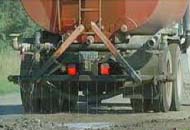 Unpaved roads compose a significant majority of roads in South Dakota. These roadways need regular and emergency maintenance, costing South Dakota local and county government a significant amount of money and endangering the safety of local drivers. The mechanical stability of stabilized gravel roadways depends on the type of stabilizers used and the soil and aggregate properties such as fines contents and plasticity index. In this project,
Dr. Soonkie Nam is evaluating the mechanical behavior of unpaved roads that are mixed with bio-enzyme chemical agents. This project will provide detailed information on how to more efficiently use bio-enzymes in unpaved road stabilization.
Unpaved roads compose a significant majority of roads in South Dakota. These roadways need regular and emergency maintenance, costing South Dakota local and county government a significant amount of money and endangering the safety of local drivers. The mechanical stability of stabilized gravel roadways depends on the type of stabilizers used and the soil and aggregate properties such as fines contents and plasticity index. In this project,
Dr. Soonkie Nam is evaluating the mechanical behavior of unpaved roads that are mixed with bio-enzyme chemical agents. This project will provide detailed information on how to more efficiently use bio-enzymes in unpaved road stabilization.
Development of Alkali-Activated Geopolymers Using Waste Materials
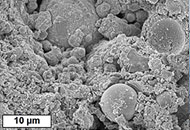 Geopolymers are produced by mixing an aluminosilicate precursor with a highly concentrated aqueous alkali activator to form a hardened binder. Geopolymers have broad applications in the construction field as a cost-effective and less carbon intensive alternative to ordinary portland cement (OPC) concrete due to their high dimensional stability and mechanical strength. This research, led by Dr. Chris Shearer, examines potentially suitable precursor materials from industrial waste streams to synthesize geopolymers. The geopolymer samples are assessed based upon their mechanical and durability performance. The structure and chemistry of the binders are also analyzed to determine their fundamental properties.
Geopolymers are produced by mixing an aluminosilicate precursor with a highly concentrated aqueous alkali activator to form a hardened binder. Geopolymers have broad applications in the construction field as a cost-effective and less carbon intensive alternative to ordinary portland cement (OPC) concrete due to their high dimensional stability and mechanical strength. This research, led by Dr. Chris Shearer, examines potentially suitable precursor materials from industrial waste streams to synthesize geopolymers. The geopolymer samples are assessed based upon their mechanical and durability performance. The structure and chemistry of the binders are also analyzed to determine their fundamental properties.
Use of Energy By-Products as Supplementary Cementitious Materials
The use of finely divided pozzolanic or latent hydraulic materials as a partial replacement of cement in concrete can improve strength development and durability. This research, led by
Dr. Chris Shearer, investigates new and existing types of energy by-products for use in concrete as supplementary cementitious materials (SCMs). Research has focused on two emerging energy by-products, biomass ash and co-fired fly ash. These ashes are generated by firing biomass and co-firing biomass with coal, respectively. The viability of these ashes for use as SCMs is evaluated by measuring their impact on the early- and late-age properties of concrete in addition to determining their compliance with existing standards. Furthermore, the chemical and physical characteristics of the ashes are linked to binder properties to better understand their effect on concrete performance.
Quality Base Material Produced Using Full Depth Reclamation on Existing Asphalt Pavement Structure
Full depth reclamation (FDR) is one of the three major types of asphalt recycling techniques. FDR is considered when the pavement is highly deteriorated or has deep cracking due to design deficiencies or an inadequate base. Other indications that a road could use FDR are frequent transverse and lateral cracking, reflective cracking, severe rutting and frost heaves. Studies have shown that asphalt recycling can cost up to 50% less than conventional methods, therefore, it is a cost effective and environmentally friendly method of asphalt pavement recycling. FDR consists of pulverizing the entire asphalt pavement section along with a predetermined amount of underlying base, sub-base, or sub-grade material to produce a new base course through compaction and addition of additives, which is then overlaid with a new riding surface course. This process can be done by pulverization and mixing in-place with a reclaimer/stabilizer machine or by pulverization in-place then hauling the recycled material to a central plant for mixing. This recently completed research was a $1.3 M project sponsored by the Federal Highway Administration. Research scopes include: development of standardized laboratory testing methods, development of FDR mix design guide, field tests, establishment of laboratory testing and design procedures, and field performance monitoring.

Development of Geo-Biological Dust Control Technique
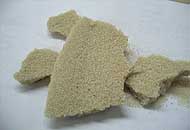 Dust control in construction sites, open pit mining areas, quarries, and unpaved roads has been an extremely important and sensitive issue because of the immediate effects of dusts on human living conditions and on efficient operations. This research addresses the potential use of microbial methods for suppressing dusts specifically in construction sites. Microbial method utilizing a common soil microorganism, Sporosarcina pasteurii, is well known for its environmentally friendliness. Our previous studies indicate that this microbial treatment provides strong, aggregated soil particles to prevent them from being airborne. The microbial dust suppression also persists for a much longer period, eliminating the need of frequent reapplication of dust suppressant associated with conventional methods. Main scopes of this research, supported by NSF, Samsung E&C, and Lotte E&C includes: (1) bench-scale biological laboratory study to identify the effectiveness and appropriateness of three microbial dust suppression methods on different types of soil and site conditions; (2) geotechnical laboratory study to provide necessary support for the biological study; and (3) full-scale field implementation to demonstrate the effectiveness of the developed microbial dust suppression technique. Eventually, this technology is expected to be applied to the minimization of global spread of desertification.
Dust control in construction sites, open pit mining areas, quarries, and unpaved roads has been an extremely important and sensitive issue because of the immediate effects of dusts on human living conditions and on efficient operations. This research addresses the potential use of microbial methods for suppressing dusts specifically in construction sites. Microbial method utilizing a common soil microorganism, Sporosarcina pasteurii, is well known for its environmentally friendliness. Our previous studies indicate that this microbial treatment provides strong, aggregated soil particles to prevent them from being airborne. The microbial dust suppression also persists for a much longer period, eliminating the need of frequent reapplication of dust suppressant associated with conventional methods. Main scopes of this research, supported by NSF, Samsung E&C, and Lotte E&C includes: (1) bench-scale biological laboratory study to identify the effectiveness and appropriateness of three microbial dust suppression methods on different types of soil and site conditions; (2) geotechnical laboratory study to provide necessary support for the biological study; and (3) full-scale field implementation to demonstrate the effectiveness of the developed microbial dust suppression technique. Eventually, this technology is expected to be applied to the minimization of global spread of desertification.
Suction Piles and Suction Anchors for Off-shore Structures
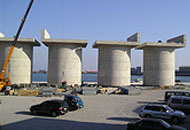 An Innovative underwater permanent foundation system utilizing suction piles was introduced in the offshore industry in recent years. Since then, this new foundation system has been successfully used in numerous occasions on a variety of offshore structures in a wide range of environments due to its low cost, simplicity, efficiency, and reliability. Originally conceived as a retrievable mooring point for floating oil and gas production facilities in the open sea, suction piles are expected to provide a viable alternative to the conventional anchoring system that utilizes either drag embedment anchors, plate anchors, or drilled or driven piles. Suction piles typically have a large diameter with a relatively large diameter-to-length ratio. They are installed by applying a suction pressure inside the pile, which acts as an external surcharge to push the pile into the seafloor. They may be retrieved later by applying a positive pressure inside the pile. Most significant advantages of suction piles are (1) easy installation, (2) large bearing capacity, and (3) retrievability. Suction anchors have been developed to provide resistance against tension. They are buried at considerable depths of seafloor and placed with a suction pile. Suction anchors therefore can replace conventional tension resisting foundation systems, since they can provide much higher capacity with less cost. Research on suction piles and suction anchors has been supported in the past and currently by the US Navy, National Science Foundation, Daewoo E&C, and Korea Electric Power Corporation. Suction piles and suction anchors were designed and used for foundations of caisson-type breakwater, temporary mooring of immersed under-sea tunnel sections, and foundations for floating breakwater. Currently, 3-7 mega-watt off-shore windmill foundation is being designed with these systems.
An Innovative underwater permanent foundation system utilizing suction piles was introduced in the offshore industry in recent years. Since then, this new foundation system has been successfully used in numerous occasions on a variety of offshore structures in a wide range of environments due to its low cost, simplicity, efficiency, and reliability. Originally conceived as a retrievable mooring point for floating oil and gas production facilities in the open sea, suction piles are expected to provide a viable alternative to the conventional anchoring system that utilizes either drag embedment anchors, plate anchors, or drilled or driven piles. Suction piles typically have a large diameter with a relatively large diameter-to-length ratio. They are installed by applying a suction pressure inside the pile, which acts as an external surcharge to push the pile into the seafloor. They may be retrieved later by applying a positive pressure inside the pile. Most significant advantages of suction piles are (1) easy installation, (2) large bearing capacity, and (3) retrievability. Suction anchors have been developed to provide resistance against tension. They are buried at considerable depths of seafloor and placed with a suction pile. Suction anchors therefore can replace conventional tension resisting foundation systems, since they can provide much higher capacity with less cost. Research on suction piles and suction anchors has been supported in the past and currently by the US Navy, National Science Foundation, Daewoo E&C, and Korea Electric Power Corporation. Suction piles and suction anchors were designed and used for foundations of caisson-type breakwater, temporary mooring of immersed under-sea tunnel sections, and foundations for floating breakwater. Currently, 3-7 mega-watt off-shore windmill foundation is being designed with these systems.
Riverbank Erosion and Stability on the Missouri River
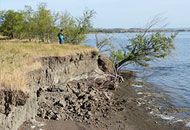 The increasing number of extreme climate events is ultimately responsible for severe river flow conditions that cause drought, flooding, and freezing. These conditions alter the hydraulic and geotechnical properties of both the river flow and riverbanks, and eventually make riverbanks more susceptible to bank erosion and mass failure. In South Dakota, sections of the Missouri River have experienced significant loss of riverbanks due to erosion and mass failure, directly affecting several local communities including a Native American tribe. A research team led by
Dr. Soonkie Nam at South Dakota Mines has teamed up with USGS researchers to investigate the riverbanks near Lower Brule, SD. In situ and laboratory geotechnical and hydraulic tests are being performed to identify the major factors responsible for the erosion and bank failures, and numerical analysis models that take into account unsaturated soil properties are currently being considered.
The increasing number of extreme climate events is ultimately responsible for severe river flow conditions that cause drought, flooding, and freezing. These conditions alter the hydraulic and geotechnical properties of both the river flow and riverbanks, and eventually make riverbanks more susceptible to bank erosion and mass failure. In South Dakota, sections of the Missouri River have experienced significant loss of riverbanks due to erosion and mass failure, directly affecting several local communities including a Native American tribe. A research team led by
Dr. Soonkie Nam at South Dakota Mines has teamed up with USGS researchers to investigate the riverbanks near Lower Brule, SD. In situ and laboratory geotechnical and hydraulic tests are being performed to identify the major factors responsible for the erosion and bank failures, and numerical analysis models that take into account unsaturated soil properties are currently being considered.
Materials Testing for Mechanistic-Empirical Pavement Design
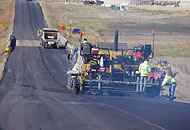 The Mechanistic-Empirical Pavement Design Guide (MEPDG) has been developed for a new pavement design and analysis tool that requires new design parameters. This study is designed to determine the resilient modulus (Mr) and dynamic modulus (E*) values for typical soil and construction materials used in the state and will eventually lead to the creation of a comprehensive database containing pertinent material input variables that will be available for future mechanistic-empirical designs. The research group led by
Dr. Soonkie Nam and
Dr. Lance Roberts have begun testing samples of subgrade materials, hot mix asphalt (HMA), and warm mix asphalt (WMA) from across South Dakota. South Dakota Mines recently acquired a state-of-the-art Asphalt Mixture Performance Tester (AMPT; also known as a Simple Performance Tester) that has the ability to perform resilient modulus, dynamic modulus, and repeated load triaxial tests utilizing custom designed operational software.
The Mechanistic-Empirical Pavement Design Guide (MEPDG) has been developed for a new pavement design and analysis tool that requires new design parameters. This study is designed to determine the resilient modulus (Mr) and dynamic modulus (E*) values for typical soil and construction materials used in the state and will eventually lead to the creation of a comprehensive database containing pertinent material input variables that will be available for future mechanistic-empirical designs. The research group led by
Dr. Soonkie Nam and
Dr. Lance Roberts have begun testing samples of subgrade materials, hot mix asphalt (HMA), and warm mix asphalt (WMA) from across South Dakota. South Dakota Mines recently acquired a state-of-the-art Asphalt Mixture Performance Tester (AMPT; also known as a Simple Performance Tester) that has the ability to perform resilient modulus, dynamic modulus, and repeated load triaxial tests utilizing custom designed operational software.
Improvement of Engineering Properties of Soil and Agricultural By-products
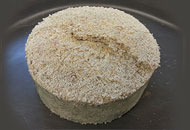 The need to acquire good quality soil is a major factor contributing to higher construction costs. Improving substandard soils with stabilizing agents has proven to be both practical and economical for many types of earth works. Multiple options have been proposed for the chemical stabilization of soils, several of which have been successfully demonstrated in engineering projects. However, the chemicals used may not be environmentally friendly and can create secondary issues such as the corrosion of contacting materials and the leaching of chemicals into the subsoil, groundwater and aquifers. Developing new stabilizing agents that improve the mechanical behavior of problematic soils but have only a minimal environmental impact has long been a goal for researchers. The primary objective of this study is therefore to study the mechanical, chemical and biological characteristics of substandard soils mixed with agricultural by-products. The preliminary results indicate that shear strength does indeed increase due to the addition of this material, highlighting the potential utility of further research on the application of agricultural by-products in soil improvement.
The need to acquire good quality soil is a major factor contributing to higher construction costs. Improving substandard soils with stabilizing agents has proven to be both practical and economical for many types of earth works. Multiple options have been proposed for the chemical stabilization of soils, several of which have been successfully demonstrated in engineering projects. However, the chemicals used may not be environmentally friendly and can create secondary issues such as the corrosion of contacting materials and the leaching of chemicals into the subsoil, groundwater and aquifers. Developing new stabilizing agents that improve the mechanical behavior of problematic soils but have only a minimal environmental impact has long been a goal for researchers. The primary objective of this study is therefore to study the mechanical, chemical and biological characteristics of substandard soils mixed with agricultural by-products. The preliminary results indicate that shear strength does indeed increase due to the addition of this material, highlighting the potential utility of further research on the application of agricultural by-products in soil improvement.